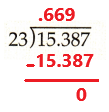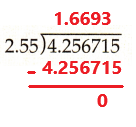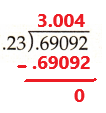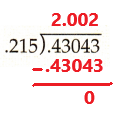Practice questions available in McGraw Hill Math Grade 6 Answer Key PDF Unit Test Lessons 10-14 will engage students and is a great way of informal assessment.
McGraw-Hill Math Grade 6 Unit Test Lessons 10-14 Answer Key
In which place does the underlined number reside?
Question 1.
3,456.987 ___________
Answer:
The underlined number 8 reside at hundredths place.
Question 2.
539,992 ______________
Answer:
The underlined number 3 reside at Ten thousands place.
Question 3.
45,573.7934 ___________
Answer:
The underlined number 4 reside at Ten thousandths place.
Question 4.
817,993 _______________
Answer:
The underlined number 8 reside at hundred thousands place.
Round.
Question 5.
Round 567,893.546 to the nearest hundredth.
Answer:
567,893.55
Explanation:
We can see thousandths place is 6 which is greater than or equal to 5. So, we need to add 1 to the hundredths place in order to round it to the nearest hundredth. Finally after rounding the number will be 567,893.55.
Question 6.
Round 495,679.559 to the nearest ten thousand.
Answer:
500,000
Explanation:
We can see thousands place is 5 which is greater than or equal to 5. So, we need to add 1 to the thousands place in order to round it to the nearest ten thousands. Finally after rounding the number will be 500,000.
Convert decimals to fractions.
Question 7.
.85 = ____________
Answer:
The given decimal is .85.
To convert .85 to fraction we need to multiply and divide with 100. Because after decimal point there are two digits. So,10 to the power of 2 is equal to 100.
(.85 x 100)/100 = 85/100 = \(\frac{17}{20}\)
So, the decimal .85 is equal to the fraction \(\frac{17}{20}\).
Question 8.
.625 = ______________
Answer:
The given decimal is .625.
To convert .625 to fraction we need to multiply and divide with 1000. Because after decimal point there are three digits. So,10 to the power of 3 is equal to 1,000.
(.625 x 1000)/1000 = 625/1000 = \(\frac{5}{8}\)
So, the decimal .625 is equal to the fraction \(\frac{5}{8}\).
Question 9.
.06 = ______________
Answer:
The given decimal is .06.
To convert .06 to fraction we need to multiply and divide with 100. Because after decimal point there are two digits. So,10 to the power of 2 is equal to 100.
(.06 x 100)/100 = 6/100 = \(\frac{3}{50}\)
So, the decimal .06 is equal to the fraction \(\frac{3}{50}\).
Question 10.
.375 = _____________
Answer:
The given decimal is .375.
To convert .375 to fraction we need to multiply and divide with 1000. Because after decimal point there are three digits. So,10 to the power of 3 is equal to 1,000.
(.375 x 1000)/1000 = 375/1000 = \(\frac{3}{8}\)
So, the decimal .375 is equal to the fraction \(\frac{3}{8}\).
Convert fractions to decimals.
Question 11.
\(\frac{4}{5}\) = ______________
Answer:
To convert the fraction \(\frac{4}{5}\) to decimal we need to perform division operation. Divide 4 by 5 the result is equal to 0.8.
\(\frac{4}{5}\) = 0.8
So, the fraction \(\frac{4}{5}\) is equal to decimal 0.8.
Question 12.
\(\frac{4}{15}\) = ______________
Answer:
To convert the fraction \(\frac{4}{15}\) to decimal we need to perform division operation. Divide 4 by 15 the result is equal to 0.2667.
\(\frac{4}{15}\) = 0.2667
So, the fraction \(\frac{4}{15}\) is equal to decimal 0.2667.
Question 13.
\(\frac{7}{18}\) = ______________
Answer:
To convert the fraction \(\frac{7}{18}\) to decimal we need to perform division operation. Divide 7 by 18 the result is equal to 0.3889.
\(\frac{7}{18}\) = 0.3889
So, the fraction \(\frac{7}{18}\) is equal to decimal 0.3889.
Question 14.
4\(\frac{1}{8}\) = ______________
Answer:
4\(\frac{1}{8}\) = (32 + 1)/8 = \(\frac{33}{8}\)
The mixed number 4\(\frac{1}{8}\) in fraction form as \(\frac{33}{8}\).
To convert the fraction \(\frac{33}{8}\) to decimal we need to perform division operation. Divide 33 by 8 the result is equal to 4.125.
\(\frac{33}{8}\) = 4.125
So, the fraction 4\(\frac{1}{8}\) is equal to decimal 4.125.
Put the decimals in order from greatest to least.
Question 15.
.22, .45, .76, .765, .43, .432, .226, .89
Answer:
The given decimals from greatest to least are .89, .765, .76, .45, .432, .43, .226, .22.
Question 16
.117, .017, .033. .087, .243, .2043, .657, .0657, .0605
Answer:
The given decimals from greatest to least are .657, .243, .2043, .117, .087, .0657, .0605, .033, .017
Add or Subtract.
Question 17.

Answer:

Explanation:
Perform addition operation on above two given decimal numbers. Add .57397 with .3542 the sum is equal to .92817.
Question 18.

Answer:

Explanation:
Perform addition operation on above two given decimal numbers. Add .034056 with .43776 the sum is equal to .471816.
Question 19.

Answer:

Explanation:
Perform addition operation on above three given decimal numbers. Add .564 with .667 and .35832 the sum is equal to 1.58932.
Question 20.

Answer:

Explanation:
Perform subtraction operation on above two given numbers. Subtract 1.2505 from 4.5466 the difference is equal to 3.2961.
Question 21.

Answer:

Explanation:
Perform subtraction operation on above two given numbers. Subtract .600043 from .792654 the difference is equal to .192611.
Question 22.

Answer:

Explanation:
Perform subtraction operation on above two given numbers. Subtract .78334 from .1.476 the difference is equal to .69266.
Question 23.
Gwen went to the store to buy supplies for school. She spent $1.50 on a pencil sharpener, $4.05 on a set of markers, $3.70 for a used compass, $3.09 for a memo pad, and $6.28 for a new water bottle. How much did she spend altogether?
Answer:
Gwen spent $1.50 on a pencil sharpener.
Gwen spent $4.05 on a set of markers.
Gwen spent $3.70 for a used compass.
Gwen spent $3.09 for a memo pad.
Gwen spent $6.28 for a new water bottle.
$1.50 + $4.05 + $3.70 + $3.09 + $6.28 = $18.62
She spend altogether $18.62.
Calculate.
Question 24.

Answer:

Explanation:
Perform multiplication operation on above two given numbers. Multiply .3033 with 9 the product is equal to 2.7297.
Question 25.

Answer:

Explanation:
Perform multiplication operation on above two given numbers. Multiply 24.615 with 45 the product is equal to 1107.675.
Question 26.

Answer:

Explanation:
Perform multiplication operation on above two given numbers. Multiply .873 with 15 the product is equal to 13.095.
Question 27.

Answer:

Explanation:
Perform multiplication operation on above two given numbers. Multiply .539 with .98 the product is equal to .52822.
Question 28.

Answer:

Explanation:
Perform multiplication operation on above two given numbers. Multiply .438 with .64 the product is equal to .28032.
Question 29.

Answer:

Explanation:
Perform multiplication operation on above two given numbers. Multiply .7784 with .647 the product is equal to .5036248.
Question 30.
Jamie went to the store to buy lunch for his 6 friends. For each friend, he spent $4.75 for a sandwich, $1.25 for a cold beverage, and $.56 for a piece of fruit. How much did he spend in total to buy lunch for his friends?
Answer:
Jamie went to the store to buy lunch for his 6 friends.
For each friend, he spent $4.75 for a sandwich, $1.25 for a cold beverage, and $.56 for a piece of fruit.
6 x ($4.75 + $1.25 + $.56) = 6 x $6.56 = $39.36
Jamie spend $39.36 in total to buy lunch for his friends.
Calculate.
Question 31.
![]()
Answer:

Explanation:
Perform division operation on above two numbers. Here dividend is .9693 and divisor is 3. Divide .9693 by 3 the quotient is equal to .3231 and remainder is 0.
Question 32.
![]()
Answer:

Explanation:
Perform division operation on above two numbers. Here dividend is 15.387 and divisor is 23. Divide 15.387 by 23 the quotient is equal to .669 and remainder is 0.
Question 33.
![]()
Answer:

Explanation:
Perform division operation on above two numbers. Here dividend is 4.256715 and divisor is 2.55. Divide 4.256715 by 2.55 the quotient is equal to 1.6693 and remainder is 0.
Question 34.
![]()
Answer:

Explanation:
Perform division operation on above two numbers. Here dividend is .69092 and divisor is .23. Divide .69092 by .23 the quotient is equal to 3.004 and remainder is 0.
Question 35.
![]()
Answer:

Explanation:
Perform division operation on above two numbers. Here dividend is .545 and divisor is .025. Divide .545 by .025 the quotient is equal to 21.8 and remainder is 0.
Question 36.
![]()
Answer:

Explanation:
Perform division operation on above two numbers. Here dividend is .3224672 and divisor is .44. Divide .3224672 by .44 the quotient is equal to .73288 and remainder is 0.
Question 37.
![]()
Answer:

Explanation:
Perform division operation on above two numbers. Here dividend is .43043 and divisor is .215. Divide .43043 by .215 the quotient is equal to .2.002 and remainder is 0.
Question 38.
![]()
Answer:

Explanation:
Perform division operation on above two numbers. Here dividend is 124 and divisor is .25. Divide 124 by .25 the quotient is equal to 496 and remainder is 0.
Question 39.
Theo and his drama club raised a total of $1,563.75 for the local Boys and Girls Club. There are 15 people in the drama club. How much, per person, did the drama club raise? ___________
Answer:
Theo and his drama club raised a total of $1,563.75 for the local Boys and Girls Club.
There are 15 people in the drama club.
$1,563.75/15 = $104.25
The drama club raise $104.25 per person.
Question 40.
What is 30% of \(\frac{3}{5}\)?
Answer:
30% = 30/100
Multiply 30% with \(\frac{3}{5}\).
= 30/100 × \(\frac{3}{5}\)
= \(\frac{9}{50}\)
Explanation:
The given 30% in fraction form as 30/100. Multiply 30% with \(\frac{3}{5}\) the product is equal to \(\frac{9}{50}\). So, 30% of \(\frac{3}{5}\) is \(\frac{9}{50}\).
Question 41.
What is 40% of 240?
Answer:
40% = 40/100
Multiply 40% with 240.
= 40/100 × 240
= 4 x 24
= 96
Explanation:
The given 40% in fraction form as 40/100. Multiply 40% with 240 the product is equal to 96. So, 40% of 240 is 96.
Question 42.
What is \(\frac{3}{4}\) of 240%?
Answer:
240% = 240/100
Multiply \(\frac{3}{4}\) with 240%.
= \(\frac{3}{4}\) × 240/100
= 180%
Explanation:
The given 240% in fraction form as 240/100. Multiply \(\frac{3}{4}\) with 240% the product is equal to 180%. So,\(\frac{3}{4}\) of 240% is 180%.
Question 43.
\(\frac{5}{18}\) is what percentage of \(\frac{25}{72}\)?
Answer:
\(\frac{5}{18}\) x \(\frac{72}{25}\) x 100 = 80%
Question 44.
What is \(\frac{1}{3}\) of 42%?
Answer:
42% = 42/100
Multiply \(\frac{1}{3}\) with 42%.
= \(\frac{1}{3}\) × 42/100
= 14%
Explanation:
The given 42% in fraction form as 42/100. Multiply \(\frac{1}{3}\) with 42% the product is equal to 14%. So,\(\frac{1}{3}\) of 42% is 14%.
Question 45.
What is \(\frac{4}{5}\) of 90%?
Answer:
90% = 90/100
Multiply \(\frac{4}{5}\) with 90%.
= \(\frac{4}{5}\) × 90/100
= 72%
Explanation:
The given 90% in fraction form as 90/100. Multiply \(\frac{4}{5}\) with 90% the product is equal to 72%. So, \(\frac{4}{5}\) of 90% is 72%.
Question 46.
What is 23% of .605?
Answer:
23% = 0.23
Multiply 23% with .605.
= 0.23 × 0.605
= 0.13915
Explanation:
The given 23% in decimal form as 0.23. Multiply 23% with 0.605 the product is equal to 0.13915. So, 23% of .605 is equal to 0.13915.
Question 47.
What is 44% of .906?
Answer:
44% = 0.44
Multiply 44% with .906.
= 0.44 × 0.906
= 0.39864
Explanation:
The given 44% in decimal form as 0.44. Multiply 44% with 0.906 the product is equal to 0.39864. So, 44% of .906 is equal to 0.39864.